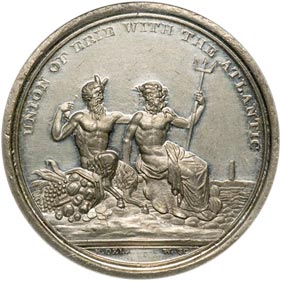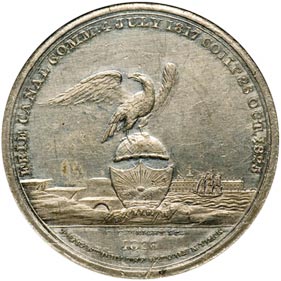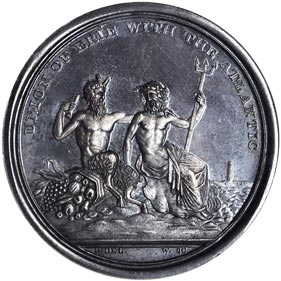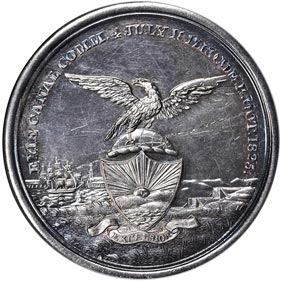ERIE CANAL COMPLETION
1826
NEW YORK CITY, NY
Medal issued by Common Council, City of New York; designed by Archibald Robertson; engraved by Charles Cushing Wright with lettering by Richard Trested on dies prepared by William Williams; struck by Maltby Pelletreau.
Erie Canal Commission created 1810 by NY Legislature; DeWitt Clinton, later Governor, served as member 10 years without pay. Ground broken July 4, 1817, at Rome, NY. Over 8 years and $7,000,000 later, Canal stretched 364 miles "straight as the lay of the land would permit" from Hudson River to Lake Erie; 83 locks required for "greatest engineering feat of modern times...costliest, most successful project yet undertaken in the New World."
Originally dubbed "Clinton's Folly" by many, Canal proved one of main factors in our national development by directly opening West to agriculture; reduced freight cost and time, Albany to Buffalo, from $100 per ton and 45 days (by wagon) to $5 and 6 days; passengers paid 5 cents per mile, including 3 meals daily. By 1836, tolls had paid off entire cost; made New York City first seaport in U.S., passing Philadelphia. Now part of NY Barge Canal System, original 40 ft. width and 4 ft. depth have been increased substantially.
Formal opening was Oct. 26, 1825, with vessel Seneca Chief carrying Governor Clinton departing Buffalo; arrived New York City Nov. 4. Long water-parade behind "moved slowly" with banquets, parades, etc. "at every town" en route; climaxed by huge New York celebration early 1826. Fifty-one Gold medals struck; presented to "crowned heads of world and eminent men" including General Lafayette and 3 surviving signers of Declaration of Independence. "Several hundred" pieces struck in Silver and White Metal (pewter); presented to guests and officials.
Obv. Two full seated figures depicting Pan and Neptune, to r. of Pan is cornucopia; in background is lighthouse and sea; below l. microscopic R. Del, below r. microscopic W. Sc.; above all, around Union of Erie with the Atlantic.
Rev. In center is New York State Coat of Arms; to l. is section of Canal; in background is sailing ship and distant view of city; below 1826 / Presented by the City of New York; above all, around Erie Canal Comm. 4 July 1817 Comp. 26 Oct. 1825; microscopic C. C. Wright Sc just below center design.


Photos courtesy of Al Hancovsky
HK-1 White Metal. 45mm.
Issued in a round wooden container made by Daniel Kerr and Duncan Phyfe from the original wood of the Seneca Chief.
HK-1000 Silver.
HK-1001 Gold.
Issued in a round Morocco case made by Robert Tanner.
Obv. Two full seated figures depicting Pan and Neptune, to r. of Pan is cornucopia; in background is lighthouse and sea; below l. microscopic R. Del, below r. microscopic W. Sc.; above all, around Union of Erie with the Atlantic.
Rev. In center is New York State Coat of Arms; to l. is section of Canal; in background is sailing ship and distant view of city; below 1826 / Presented by the City of New York; above all, around Erie Canal Comm. 4 July 1817 Comp. 26 Oct. 1825; microscopic C. C. Wright Sc just below center design.
Discovered by Vicken Yegparian in 2017. The only known example with this reverse shares an early die state of the same obverse die as used for Nos. 1, 1000, and 1001. The presence of a bisecting die crack suggests that No. 1000a was struck first, then the reverse die failed, then the others were struck with a new reverse die.
HK-1000a Silver. 44mm.
HK-2 to HK-4

